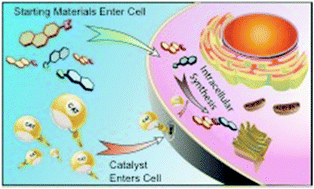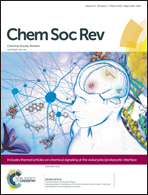Designed transition metal catalysts for intracellular organic synthesis
Abstract
The development of synthetic, metal-based catalysts to perform intracellular bioorthogonal reactions represents a relatively new and important area of research that combines transition metal catalysis and chemical biology. The ability to perform reactions in cellulo, especially those transformations without a natural counterpart, offers a versatile tool for medicinal chemists and chemical biologists. With proper modification of the metal catalysts, it is even possible to direct a reaction to certain intracellular sites. This review highlights advances in this new area, from early work on intracellular functional group conversions to recent advances in intracellular synthesis of drugs, including cytotoxic agents. Both the fundamental and applied aspects of this approach to intracellular synthesis are reviewed.

- This article is part of the themed collection: Probes for in vitro and in vivo fluorescence imaging


 Please wait while we load your content...
Please wait while we load your content...